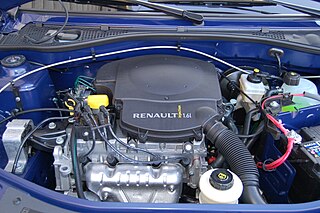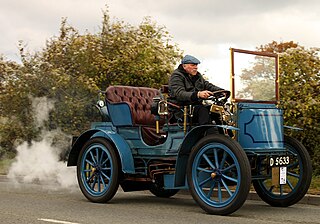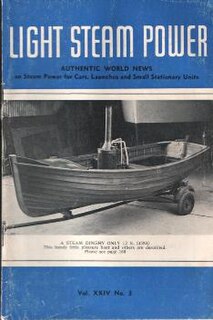The Locomobile Company of America was a pioneering American automobile manufacturer founded in 1899, and known for its dedication to precision in the pre-assembly-line era. It was one of the earliest car manufacturers in the advent of the automobile age. For the first two years after its founding, the company was located in Watertown, Massachusetts. Production was transferred to Bridgeport, Connecticut, in 1900, where it remained until the company's demise in 1929. The company manufactured affordable, small steam cars until 1903, when production switched entirely to internal combustion-powered luxury automobiles. Locomobile was taken over in 1922 by Durant Motors and eventually went out of business in 1929. All cars ever produced by the original company were always sold under the brand name Locomobile.

An antique car is an automobile that is an antique. Narrower definitions vary based on how old a car must be to qualify. The Antique Automobile Club of America defines an antique car as over 25 years of age. However, the legal definitions for the purpose of antique vehicle registration vary widely. The antique car era includes the Veteran era, the Brass era, and the Vintage era, which range from the beginning of the automobile up to the 1930s. Later cars are often described as classic cars. In original or originally restored condition antiques are very valuable and are usually either protected and stored or exhibited in car shows but are very rarely driven.

The Stanley Motor Carriage Company was an American manufacturer of steam-engine vehicles; it operated from 1902 to 1924. The cars made by the company were colloquially called Stanley Steamers, although several different models were produced.

De Dion-Bouton was a French automobile manufacturer and railcar manufacturer operating from 1883 to 1953. The company was founded by the Marquis Jules-Albert de Dion, Georges Bouton, and Bouton's brother-in-law Charles Trépardoux.

The early history of the automobile can be divided into a number of eras, based on the prevalent means of propulsion. Later periods were defined by trends in exterior styling, size, and utility preferences.

As of 2013 there were a wide variety of propulsion systems available or potentially available for automobiles and other vehicles. Options included internal combustion engines fueled by petrol, diesel, propane, or natural gas; hybrid vehicles, plug-in hybrids, fuel cell vehicles fueled by hydrogen and all electric cars. Fueled vehicles seemed to have the short term advantage due to the limited range and high cost of batteries. Some options required construction of a network of fueling or charging stations. With no compelling advantage for any particular option car makers pursued parallel development tracks using a variety of options. Reducing the weight of vehicles was one strategy being employed.
The following outline is provided as an overview of and topical guide to automobiles:

Gardner-Serpollet was a French manufacturer of steam-powered cars in the early 20th century. Léon Serpollet is credited with inventing and perfecting the flash boiler in the late 1800s.

A car is a wheeled motor vehicle used for transportation. Most definitions of car say they run primarily on roads, seat one to eight people, have four tires, and mainly transport people rather than goods.

Burnham Overy Staithe Windmill is a Grade II* listed building tower mill at Burnham Overy Staithe, Norfolk, England which has been converted to holiday accommodation.

The Jackson Automobile Company was an American Brass Era automobile manufacturer located in and named for Jackson, Michigan. The company produced the Jackson from 1903 to 1923, as well as the 1903 Jaxon steam car and the 1904 Orlo.
Binney is surname of Scottish origin. Notable people with the surname include:
William L. Grout (1833–1908) was an U. S. industrialist and pioneer manufacturer of sewing machines and automobiles.

Stearns Steam Carriage Company (1901–1904) was a manufacturer of steam automobiles in Syracuse, New York, founded by Edward C. Stearns, an industrialist. Stearns built his first automobile in 1899, an electric which sold so few models through 1900 that the firm changed to steam power in 1901 when the company was incorporated. The company was also known as the Stearns Automobile Company.

Light Steam Power was a magazine dedicated to amateur and small-scale interest in steam power. Its masthead for some years described itself as, "Authentic World News on Steam Power for Cars, Launches and Small Stationary Units".
This is a chronological index for the start year for motor vehicle brands. For manufacturers that went on to produce many models, it represents the start date of the whole brand; for the others, it usually represents the date of appearance of the main model that was produced.












